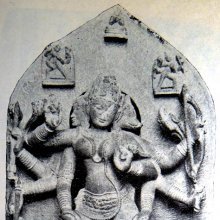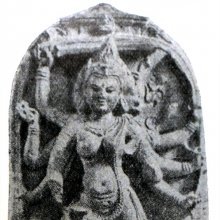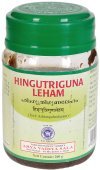Saindhava, Saimdhava: 29 definitions
Introduction:
Saindhava means something in Buddhism, Pali, Hinduism, Sanskrit, Marathi, biology. If you want to know the exact meaning, history, etymology or English translation of this term then check out the descriptions on this page. Add your comment or reference to a book if you want to contribute to this summary article.
Images (photo gallery)
In Hinduism
Natyashastra (theatrics and dramaturgy)
Source: Wisdom Library: Nāṭya-śāstra1) Saindhava (सैन्धव) is the Sanskrit name of one of Bharata’s sons, mentioned in the Nāṭyaśāstra 1.26-33. After Brahmā created the Nāṭyaveda (nāṭyaśāstra), he ordered Bharata to teach the science to his (one hundred) sons. Bharata thus learned the Nāṭyaveda from Brahmā, and then made his sons study and learn its proper application. After their study, Bharata assigned his sons (eg., Saindhava) various roles suitable to them.
2) Saindhava (सैन्धव) is another name for Sindhu, a country pertaining to the Āvantī local usage (pravṛtti) according to the Nāṭyaśāstra chapter 14. These pravṛttis provide information regarding costumes, languages, and manners in different countries of the world. It is mentioned that this local usage (adopted by these countries) depends on the grand style (sāttvatī) and the graceful style (kaiśikī).
3) Saindhava (सैन्धव) refers to one of the twelve types of lāsya, or “gentle form of dance” according to the Nāṭyaśāstra chapter 20. It is also known by the name Saindhavaka. These various lāsya are presented as a specific type of dramatic play (nāṭya) similar to that of the Bhāṇa type

Natyashastra (नाट्यशास्त्र, nāṭyaśāstra) refers to both the ancient Indian tradition (shastra) of performing arts, (natya—theatrics, drama, dance, music), as well as the name of a Sanskrit work dealing with these subjects. It also teaches the rules for composing Dramatic plays (nataka), construction and performance of Theater, and Poetic works (kavya).
Purana and Itihasa (epic history)
Source: archive.org: Puranic Encyclopedia1) Saindhava (सैन्धव).—A disciple of the hermit Śaunaka. (See under Guruparamparā).
2) Saindhava (सैन्धव).—Mention is made in Mahābhārata, Vana Parva, Chapter 51, Verse 25, that the inhabitants of the kingdom of Sindhu were called Saindhavas.
Source: Cologne Digital Sanskrit Dictionaries: The Purana Index1a) Saindhava (सैन्धव).—The king of Sindhu country could not defeat Arjuna supported by Kṛṣṇa;1 killed Abhimanyu during the Kurukṣetra war but was slain by Arjuna; see Jayadratha.2
1b) The horse of the Sind on which Sudyumna rode to the northern forests.*
- * Bhāgavata-purāṇa IX. 1. 23.
1c) (c) a kingdom watered by the Sindhu; noted for horses.*
- * Brahmāṇḍa-purāṇa II. 18. 48; IV. 17. 27; Matsya-purāṇa 121. 47.
1d) A disciple of Śaunaka; again divided the saṃhitā into two parts and gave to Muñjakeśa.*
- * Vāyu-purāṇa 47. 46; 61. 53; Viṣṇu-purāṇa III. 6. 12.
1e) Were enlisted by Jarāsandha against the Yadus;1 country of the.2
Source: JatLand: List of Mahabharata people and placesSaindhava (सैन्धव) is a name mentioned in the Mahābhārata (cf. I.177.19) and represents one of the many proper names used for people and places. Note: The Mahābhārata (mentioning Saindhava) is a Sanskrit epic poem consisting of 100,000 ślokas (metrical verses) and is over 2000 years old.

The Purana (पुराण, purāṇas) refers to Sanskrit literature preserving ancient India’s vast cultural history, including historical legends, religious ceremonies, various arts and sciences. The eighteen mahapuranas total over 400,000 shlokas (metrical couplets) and date to at least several centuries BCE.
Ayurveda (science of life)
Rasashastra (Alchemy and Herbo-Mineral preparations)
Source: archive.org: Rasa-Jala-Nidhi: Or Ocean of indian chemistry and alchemySaindhava refers to “rock-salt”. (see Bhudeb Mookerji and his Rasajalanidhi)
Dietetics and Culinary Art (such as household cooking)
Source: Shodhganga: Dietetics and culinary art in ancient and medieval India1) Saindhava (सैन्धव) or Lavaṇa refers to “salt”, and is commonly found in literature dealing with the topics of dietetics and culinary art, also known as Pākaśāstra or Pākakalā.—We cannot see any reference to the salt in Ṛgveda. But most of the non-Ṛgvedic Saṃhitas, Brāhmaṇas and Upaniṣads refer to salt in the name of lavaṇa or saindhava.
Saindhava or “rock-salt” is mentioned as being beneficial (hita) to the body according to the 17th century Bhojanakutūhala in the dravyaguṇāguṇa-kathana, which contains the discussions on different food articles and their dietetic effects according to the prominent Ayurvedic treatises. Here In the lavaṇa (salts) group saindhava (rock-salt) is mentioned as beneficial to the body (hita).
2) Saindhava (सैन्धव) refers to the Sindhu region mentioned in a list of regions.—According to the author people living in different regions [viz., Saindhava and Āndhraka] have their own nourishing foodstuffs [viz., matsya (fish)]. Such foodstuffs are more beneficial for them.
Veterinary Medicine (The study and treatment of Animals)
Source: Asian Agri-History: Paśu Āyurvēda (Veterinary Medicine) in GaruḍapurāṇaSaindhava (सैन्धव) refers to “rock salt”, and is used in the Viśodhana (“washing off the wound’s impurities”) of wounds (vraṇa), according to Āyurveda sections in the Garuḍapurāṇa.—[...] After Viśodhana (wash off the ulcer's/wound's impurities by medicated decoction), the following formulations can be used for śodhana (purification) and ropaṇa (healing) externally:—[... e.g.,] The eraṇḍa-mūla (Castor root), two types of haridrā (Turmeric), Citraka (Plumbago zeylanica), Viśvabheṣaja (Zingiber officinale), Rasona (Allium sativum) and saindhava (rock salt) are ground well with takra (butter milk) or kāñjī (sour gruel). [...]
Toxicology (Study and Treatment of poison)
Source: Shodhganga: Kasyapa Samhita—Text on Visha ChikitsaSaindhava (सैन्धव) or “salt” is used in the treatment of snake-bites such as those caused by the Uṣṇa, Śopha, Pītta or Ghoṇasa varietes of Maṇḍalī-snakes, according to the Kāśyapa Saṃhitā: an ancient Sanskrit text from the Pāñcarātra tradition dealing with both Tantra and Viṣacikitsā—an important topic from Āyurveda which deals with the study of Toxicology (Viṣavidyā or Sarpavidyā).—Accordingly, the treatment is mentioned as follows: “A drink prepared from butter, curd, salt (saindhava), honey and Kaṭutraya is the generic treatment for Maṇḍalī snakes. Cooked Kadamba mixed with ghee and water must be consumed. White sesame also helps in alleviating this poison. Paste made out of ginger, pepper, long pepper, and salt in equal measures mixed with butter , when applied , forms an efficacious antidote”.
Unclassified Ayurveda definitions
Source: Ancient Science of Life: Snake bite treatment in Prayoga samuccayamSaindhava (सैन्धव) refers to “rock salt”, and is employed in the treatment of poison (viṣa), such as that resulting from maṇḍali (viperine snake-bites) and maṇḍaliviṣa, according to the 20th century Prayogasamuccaya (one of the most popular and widely practised book in toxicology in Malayalam).—The third chapter covers maṇḍali (viperine) snake treatment. [...] Vegānusāra-cikitsā (stage wise treatment), specific symptoms and treatment of 16 types of maṇḍali snakes are explained here. E.g.: In rakta-maṇḍali bite, bleeding from nose and mouth, foul smell, deep enmity, hatred, fainting etc. will be seen. When these are the symptoms, curd, trikaṭu (three pungents), saindhava (rock salt), butter, honey and Kuṣṭha (Saussurea lappa) should be mixed and used internally. Management of complications in maṇḍali viṣa also has been explained. Management of complications in maṇḍaliviṣa also has been explained. [...]

Āyurveda (आयुर्वेद, ayurveda) is a branch of Indian science dealing with medicine, herbalism, taxology, anatomy, surgery, alchemy and related topics. Traditional practice of Āyurveda in ancient India dates back to at least the first millenium BC. Literature is commonly written in Sanskrit using various poetic metres.
Kavya (poetry)
Source: Wisdom Library: KavyaSaindhava refers to an ancient district or cultural territory, as mentioned in the 7th-century Mudrārākṣasa written by Viśākhadeva. Saindhava corresponds to the Sindh, around or beyond the Indus.

Kavya (काव्य, kavya) refers to Sanskrit poetry, a popular ancient Indian tradition of literature. There have been many Sanskrit poets over the ages, hailing from ancient India and beyond. This topic includes mahakavya, or ‘epic poetry’ and natya, or ‘dramatic poetry’.
Jyotisha (astronomy and astrology)
Source: Wisdom Library: Brihat Samhita by VarahamihiraSaindhava (सैन्धव) refers to an ancient kingdom identified with the people of Sindh, according to the Bṛhatsaṃhitā (chapter 5), an encyclopedic Sanskrit work written by Varāhamihira mainly focusing on the science of ancient Indian astronomy astronomy (Jyotiṣa).—Accordingly, “If there should be both lunar and solar eclipses in one month, princes will suffer both from dissensions among their own army and from wars. [...] If the eclipses should fall in the lunar month of Pauṣa, the Brāhmins and the Kṣatriyas will suffer; the people of Sindh [i.e., saindhava], the Kukuras and the Videhas will perish; there wall be slight rain and fear of famine in the land”.

Jyotisha (ज्योतिष, jyotiṣa or jyotish) refers to ‘astronomy’ or “Vedic astrology” and represents the fifth of the six Vedangas (additional sciences to be studied along with the Vedas). Jyotisha concerns itself with the study and prediction of the movements of celestial bodies, in order to calculate the auspicious time for rituals and ceremonies.
Sports, Arts and Entertainment (wordly enjoyments)
Source: archive.org: Syainika Sastra of Rudradeva with English Translation (art)Saindhava (सैन्धव) refers to “rock salt” (used in the treatment of Hawks), according to the Śyainika-śāstra: a Sanskrit treatise dealing with the divisions and benefits of Hunting and Hawking, written by Rājā Rudradeva (or Candradeva) in possibly the 13th century.—Accordingly, [while discussing the treatment of hawks]: “[...] Even Cāndi is likely to be cured by the use, for twelve days, of a plaster over it, made of turmeric and rock salt (saindhava) mixed with butter, after a leech has been applied. The leech is to be applied on the affected: part, which should then be covered with a bandage, which should be renewed every third day.”

This section covers the skills and profiencies of the Kalas (“performing arts”) and Shastras (“sciences”) involving ancient Indian traditions of sports, games, arts, entertainment, love-making and other means of wordly enjoyments. Traditionally these topics were dealt with in Sanskrit treatises explaing the philosophy and the justification of enjoying the pleasures of the senses.
General definition (in Hinduism)
Source: archive.org: Vedic index of Names and SubjectsSaindhava (सैन्धव, ‘coming from the Indus’) is a term applied to ‘water’ in the Taittirīya-saṃhitā, to Guggulu in the Atharvaveda, to a ‘horse’ in the Śatapatha-brāhmaṇa (xi. 5. 5. 12), and to ‘salt’ in the same text.
Source: archive.org: Indian Historical Quarterly Vol. 7Saindhava (सैन्धव) is the name of a country classified as Hādi (a type of Tantrik division), according to the 13th century Sammoha-tantra (fol. 7).—There are ample evidences to prove that the zone of heterodox Tantras went far beyond the natural limits of India. [...] The zones in the Sammoha-tantra [viz., Saindhava] are here fixed according to two different Tantrik modes, known as Kādi and Hādi.
Source: WikiPedia: HinduismSaindhava (सैंधव): Jayadratha.
In Buddhism
Mahayana (major branch of Buddhism)
Source: De Gruyter: A Buddhist Ritual Manual on AgricultureSaindhava (सैन्धव) refers to “marine (salt)” (suitable for an offering ceremony), according to the Vajratuṇḍasamayakalparāja, an ancient Buddhist ritual manual on agriculture from the 5th-century (or earlier), containing various instructions for the Sangha to provide agriculture-related services to laypeople including rain-making, weather control and crop protection.—Accordingly [as the Bhagavān taught the detailed offering-manual], “[...] The spell-master should perform oblations at the eastern gate. One should offer oleander wood, mustard seed, mixed with marine salt (saindhava-lavaṇa) 108 times. After the 108 fire oblations have been completed, all Nāgas send down rain showers. They all send down rain showers in Jambudvīpa, all around in the four directions. All of them become zealous. All Nāgas rejoice”.

Mahayana (महायान, mahāyāna) is a major branch of Buddhism focusing on the path of a Bodhisattva (spiritual aspirants/ enlightened beings). Extant literature is vast and primarely composed in the Sanskrit language. There are many sūtras of which some of the earliest are the various Prajñāpāramitā sūtras.
Biology (plants and animals)
Source: Google Books: CRC World Dictionary (Regional names)Saindhava in India is the name of a plant defined with Commiphora myrrha in various botanical sources. This page contains potential references in Ayurveda, modern medicine, and other folk traditions or local practices It has the synonym Commiphora playfairii (Hook.f. ex Oliv.) Engl. var. benadirensis Chiov. (among others).
Example references for further research on medicinal uses or toxicity (see latin names for full list):
· Bulletin of Miscellaneous Information, Royal Gardens, Kew (1941)
· Ann. Ist. Bot. Roma (1897)
· Handb. Pharmakogn.
· Allgemeine Naturgeschichte (1760)
· Pl. Medicin. (1828)
· Fl. Trop. E. Africa, Burser. (1991)
If you are looking for specific details regarding Saindhava, for example health benefits, chemical composition, diet and recipes, side effects, pregnancy safety, extract dosage, have a look at these references.

This sections includes definitions from the five kingdoms of living things: Animals, Plants, Fungi, Protists and Monera. It will include both the official binomial nomenclature (scientific names usually in Latin) as well as regional spellings and variants.
Languages of India and abroad
Marathi-English dictionary
Source: DDSA: The Molesworth Marathi and English Dictionarysaindhava (सैंधव).—n m (S) Rock-salt. 2 m A horse.
--- OR ---
saindhava (सैंधव).—a S Relating to the sea, marine, oceanic. 2 Relating to the river Sindh (Indus) or to the country Sindh.
Source: DDSA: The Aryabhusan school dictionary, Marathi-Englishsaindhava (सैंधव).—n m Rock-salt. m A horse. a Marine.
Marathi is an Indo-European language having over 70 million native speakers people in (predominantly) Maharashtra India. Marathi, like many other Indo-Aryan languages, evolved from early forms of Prakrit, which itself is a subset of Sanskrit, one of the most ancient languages of the world.
Sanskrit dictionary
Source: DDSA: The practical Sanskrit-English dictionarySaindhava (सैन्धव).—a. (-vī f.) सिन्धुनदीसमीपे देशे भवः अण् (sindhunadīsamīpe deśe bhavaḥ aṇ)]
1) Produced or born in the Sindhu-territory.
2) Belonging to the Indus.
3) River-born.
4) Belonging to the sea, oceanic, marine.
-vaḥ 1 A horse, especially one bred in Sindhu; दीर्घग्रीवा मुखालम्बमेहनाः पृथुलोचनाः । महान्तस्तनुरोमाणो वलिनः सैन्धवा हयाः (dīrghagrīvā mukhālambamehanāḥ pṛthulocanāḥ | mahāntastanuromāṇo valinaḥ saindhavā hayāḥ) || 'com. Mahābhārata (Bombay) 7.23.24; जिनोक्तिषु श्राद्ध- तयैव सैन्धवाः (jinoktiṣu śrāddha- tayaiva saindhavāḥ) N.1.71; धावद्भिरसिधाराभिः शकलीकृतसैन्धवाः (dhāvadbhirasidhārābhiḥ śakalīkṛtasaindhavāḥ) Śiva B.22.33.
2) Name of a sage.
3) Name of a country.
4) Name of Jayadratha, the king of Sindh; क्रोधादुक्तं सैन्धवे चार्जुनेन (krodhāduktaṃ saindhave cārjunena) Mahābhārata (Bombay) 1.1.192.
-vaḥ, -vam A kind of rock-salt.
-vāḥ m. pl.
1) The people inhabiting the Sindhu territory.
2) (In drama) A kind of Prākṛt song.
Source: Cologne Digital Sanskrit Dictionaries: Edgerton Buddhist Hybrid Sanskrit DictionarySaindhava (सैन्धव).—m. (or nt., doubtless = sindhava, q.v.), a musical instrument, probably a kind of drum: mṛdaṅgam āliṅga-saindhavāṃ paṇavāṃ Mahāvastu iii.82.3 (verse).
Source: Cologne Digital Sanskrit Dictionaries: Shabda-Sagara Sanskrit-English DictionarySaindhava (सैन्धव).—mfn.
(-vaḥ-vī-vaṃ) 1. Produced or born in Sindh. 2. Marine, aquatic, ocean or river-born. m.
(-vaḥ) A horse, (bred in Sindhu.) mn.
(-vaḥ-vaṃ) Rock-salt. n.
(-vaṃ) In dramatic literature, musical expression of disappointment with Prakrit words. f. (-vī) One of the Raginis. E. sindhu a river, &c. aṇ aff.
Source: Cologne Digital Sanskrit Dictionaries: Benfey Sanskrit-English DictionarySaindhava (सैन्धव).—i. e. sindhu + a, I. adj. 1. Marine. 2. Produced or born in Sindh, [Johnson's Selections from the Mahābhārata.] 96, 73. Ii. m. and n. Rock-salt. Iii. m. 1. A horse. 2. pl. The people of the country along the Indus, [Draupadīpramātha] 6, 6.
Source: Cologne Digital Sanskrit Dictionaries: Cappeller Sanskrit-English DictionarySaindhava (सैन्धव).—[feminine] ī belonging to the sea or to the Indus; [masculine] [plural] the inhabitants of the country near the Indus, [masculine] [neuter] a kind of rock-salt (found in this country).
Source: Cologne Digital Sanskrit Dictionaries: Monier-Williams Sanskrit-English Dictionary1) Saindhava (सैन्धव):—mf(ī)n. ([from] sindhu) relating to the sea, oceanic, marine, aquatic, [Buddhist literature]
2) belonging to or produced in or coming from the Indus or Sindh, [Taittirīya-saṃhitā] etc. etc.
3) m. a king of Sindh, [Mahābhārata; Mudrārākṣasa; Bhāgavata-purāṇa]
4) a horse ([particular] one bred in S°), [cf. Lexicographers, esp. such as amarasiṃha, halāyudha, hemacandra, etc.]
5) Name of a teacher, [Catalogue(s)]
6) ([plural]) the inhabitants of S°, [Atharva-veda.Pariś.; Mahābhārata] etc.
7) Name of a [particular] school founded by Saindhavāyana, [Viṣṇu-purāṇa]
8) m. n. a kind of rock-salt (found in Sindh), any salt, [Śatapatha-brāhmaṇa; Varāha-mihira’s Bṛhat-saṃhitā; Suśruta]
9) n. (in [dramatic language]) a song in Prākṛt (accompanied with music expressive of a lover’s disgust on being deserted by a loved woman), [Sāhitya-darpaṇa]
Source: Cologne Digital Sanskrit Dictionaries: Yates Sanskrit-English DictionarySaindhava (सैन्धव):—(vaḥ) 1. m. A horse. m. n. Rock salt. f. (ī) A Rāginī. a. Marine, produced in Sindh.
Source: DDSA: Paia-sadda-mahannavo; a comprehensive Prakrit Hindi dictionary (S)Saindhava (सैन्धव) in the Sanskrit language is related to the Prakrit word: Siṃdhava.
[Sanskrit to German]
Sanskrit, also spelled संस्कृतम् (saṃskṛtam), is an ancient language of India commonly seen as the grandmother of the Indo-European language family (even English!). Closely allied with Prakrit and Pali, Sanskrit is more exhaustive in both grammar and terms and has the most extensive collection of literature in the world, greatly surpassing its sister-languages Greek and Latin.
Kannada-English dictionary
Source: Alar: Kannada-English corpusSaiṃdhava (ಸೈಂಧವ):—
1) [adjective] of or belonging to, produced from sea.
2) [adjective] of or belonging to, native of Sindhu region in the northwest part of India.
--- OR ---
Saiṃdhava (ಸೈಂಧವ):—
1) [noun] = ಸೈಂದುಪ್ಪು [saimduppu].
2) [noun] the Sindhu region in the northwest part of India.
3) [noun] people belonging to this region.
4) [noun] a horse bred in this region.
5) [noun] the moon.
6) [noun] a parrot.
7) [noun] any poisonous substance.
8) [noun] a kind of plant.
9) [noun] (fig.) a tall and hefty man.
Kannada is a Dravidian language (as opposed to the Indo-European language family) mainly spoken in the southwestern region of India.
See also (Relevant definitions)
Starts with: Saindhavacurna, Saindhavadhana, Saindhavadi, Saindhavaghana, Saindhavaka, Saindhavakhilya, Saindhavalavana, Saindhavaprani, Saindhavaranya, Saindhavasarpis, Saindhavashila, Saindhavashilashakala, Saindhavayana, Saindhavayani.
Ends with: Dyusaindhava, Lavanasaindhava, Panasaindhava, Saktusaindhava, Saurasaindhava.
Full-text (+98): Saindhavaka, Pancalavana, Saindhavaghana, Sindhava, Saindhavayani, Lavanasaindhava, Saindhavayana, Saurasaindhava, Saimdava, Sindhuttha, Saindhavasarpis, Saindhavacurna, Saindhavakhilya, Saindhavashilashakala, Dhauteya, Shendilona, Dhautaya, Shendhelona, Shendelona, Padvisha.
Relevant text
Search found 53 books and stories containing Saindhava, Saimdhava, Saiṃdhava; (plurals include: Saindhavas, Saimdhavas, Saiṃdhavas). You can also click to the full overview containing English textual excerpts. Below are direct links for the most relevant articles:
Garga Samhita (English) (by Danavir Goswami)
Verse 6.15.25 < [Chapter 15 - The Glories of Nṛga-kūpa and Gopī-bhūmi]
Verse 6.8.4 < [Chapter 8 - The Marriages of All the Queens]
Verse 8.13.63 < [Chapter 13 - A Thousand Names of Lord Balarāma]
Impact of Vedic Culture on Society (by Kaushik Acharya)
Mingling of Cultures (R): The Saindhavas < [Chapter 4]
Systems of Administration during the Early Period (Introduction) < [Chapter 5]
4. Religious Aspect of Dāna < [Chapter 2]
The Garuda Purana (by Manmatha Nath Dutt)
Chapter CCXVII - Various Recipes for the cure of sterility, virile impotency, etc. < [Dhanvantari Samhita]
Chapter LV - Description of the Geographical situations of the different countries of the earth < [Agastya Samhita]
Chapter CCII - Various other medicinal Recipes (continued) < [Dhanvantari Samhita]
Mahabharata (English) (by Kisari Mohan Ganguli)
Section LXXVIII < [Anugita Parva]
Section LXXVII < [Anugita Parva]
Section CCLXIX < [Draupadi-harana Parva]
Sahitya-kaumudi by Baladeva Vidyabhushana (by Gaurapada Dāsa)
Text 10.67 < [Chapter 10 - Ornaments of Meaning]
Amarakoshodghatana of Kshirasvamin (study) (by A. Yamuna Devi)
Daily Life (1): Food and Drinks < [Chapter 3 - Social Aspects]
Related products
(+46 more products available)









